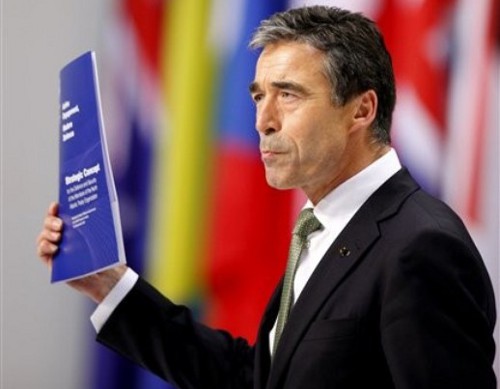
NATO’s Lisbon Summit did not satisfy everyone, but it was, by most measures, a successful summit. NATO leaders produced a Strategic Concept that reasserted NATO’s core Article 5 vocation, while offering an ambitious vision of the alliance’s role in tackling the global challenges of the 21st century.
And they took important decisions: on missile defense – while making progress toward greater partnership with Russia – and on Afghanistan, command structure and agency reforms, cyber defense, capability development, and nuclear policy, among others.
Perhaps the alliance’s heads of state and government should have provided their increasingly skeptical publics with a more clarion statement of the alliance’s mission and relevance. But faced by a challenging engagement in Afghanistan and the need to maintain defense capabilities amid massive spending cuts, today’s NATO will be judged not by what it proclaims about its relevance, but by how well it marshals the resources and political will to carry out the missions it has agreed to take on.
NATO leaders appear to understand the need for results and changing the way NATO does business – key themes highlighted by Secretary General Anders Fogh Rasmussen and many allied defense ministers in the runup to the summit that are restated throughout the Strategic Concept and Lisbon Declaration. So moving on from Lisbon, this task is clear.
While Afghanistan is the main test, maintaining and, where necessary, strengthening defense capabilities is NATO’s other defining challenge. The Lisbon documents say the right things, reaffirming, in the Strategic Concept that "NATO must have sufficient resources – financial, military and human – to carry our its missions."
Taking into account the defense spending crisis, alliance leaders agreed in the summit declaration to "pursue reform and defense transformation and continue to make our forces more deployable, sustainable [and] interoperable."
Most of this work will take place in the context of national defense budgets. NATO capability programs – funded by all or some allies – amount to less than 1 percent of alliance defense spending. But they are an important and cost-effective source of capabilities and interoperability to support NATO troops, and a vital symbol of solidarity. NATO leaders recognized this when, in the Lisbon Capabilities Commitment (LCC) they agreed to prioritize resources to deliver "the Alliance’s most pressing capability needs."
The LCC identified 11 common funded and multinational programs. Some of these address operational shortfalls in NATO and national capabilities. Others support emerging and future missions, such as missile and cyberdefense and the civil-military Comprehensive Approach.
Allies also committed to deliver long-delayed but critically needed programs like Alliance Ground Surveillance (AGS) and the Air Command and Control System (ACCS).
The most ambitious of these programs – missile defense to address the growing ballistic missile threat to NATO countries – represented perhaps the most truly strategic decision of the summit, and the declaration reflects a commendable sense of urgency. Work on command-and-control arrangements is due by March; if agreements on C2 are not in place in time, the alliance risks missing the opportunity to link up with next year’s initial deployments of the U.S. Phased Adaptive Approach.
Like many multinational programs, ACCS and AGS may be best known for delays and difficult execution. But new missions like missile and cyberdefense also have suffered from balky processes and difficulty in identifying and enforcing priorities. The LCC seeks to impose real discipline, providing, from the top, "a mandate to ensure these critical capabilities are delivered within agreed budgetary ceilings and in accordance with the Alliance’s defense planning process."
To guide future programs, NATO leaders asked for a report by March on further conceptual work on cost-effective capability development. Here, NATO nations can draw on extensive lessons learned from other NATO programs, like the value of harnessing small groups of nations (including non-NATO partner nations) to create critical mass, the need for strong management structures for complex programs, minimizing equipment variants, the value of off-the-shelf solutions in meeting urgent requirements and, potentially, the distribution of industrial share over several programs to make individual programs easier to execute.
Better cooperation between NATO and the EU’s European Defense Agency, as the Strategic Concept points out, is another way to help deliver capabilities more effectively and efficiently. Lisbon didn’t solve the political issues that have hindered collaboration, but NATO leaders encouraged the secretary general to continue his energetic diplomacy in this area.
Continued reform of NATO processes – again, a central theme at Lisbon – is an indispensable part of the solution. Headquarters reforms already in place should improve alliance decision-making and help national delegations ensure summit decisions are not stymied in committees and bureaucracies.
Rationalization of the NATO agencies around core functions of procurement, support, and communications and information will produce better governance and efficiency, as well as cost savings. Meanwhile, NATO’s processes for acquiring common-funded capabilities still need to be reformed to ensure timely program delivery.
Lisbon put in place many pieces necessary for effective and efficient delivery of capabilities that NATO will need to meet 21st century responsibilities. But delivering results in a 28-nation alliance requires sustained leadership to ensure the organization delivers the results that NATO leaders directed. If nations can muster this, it will be a true measure of the success of the Lisbon Summit.
Peter Flory was NATO Assistant Secretary for Defense Investment from January 2007 to August 2010. He is a member of the Atlantic Council’s Strategic Advisors Group and affiliated with the National Defense University’s Center for Transatlantic Security Studies. This article was originally published on Defense News. Photo Credit: AP Photo.
Image: RASSMUSEN500.jpg
